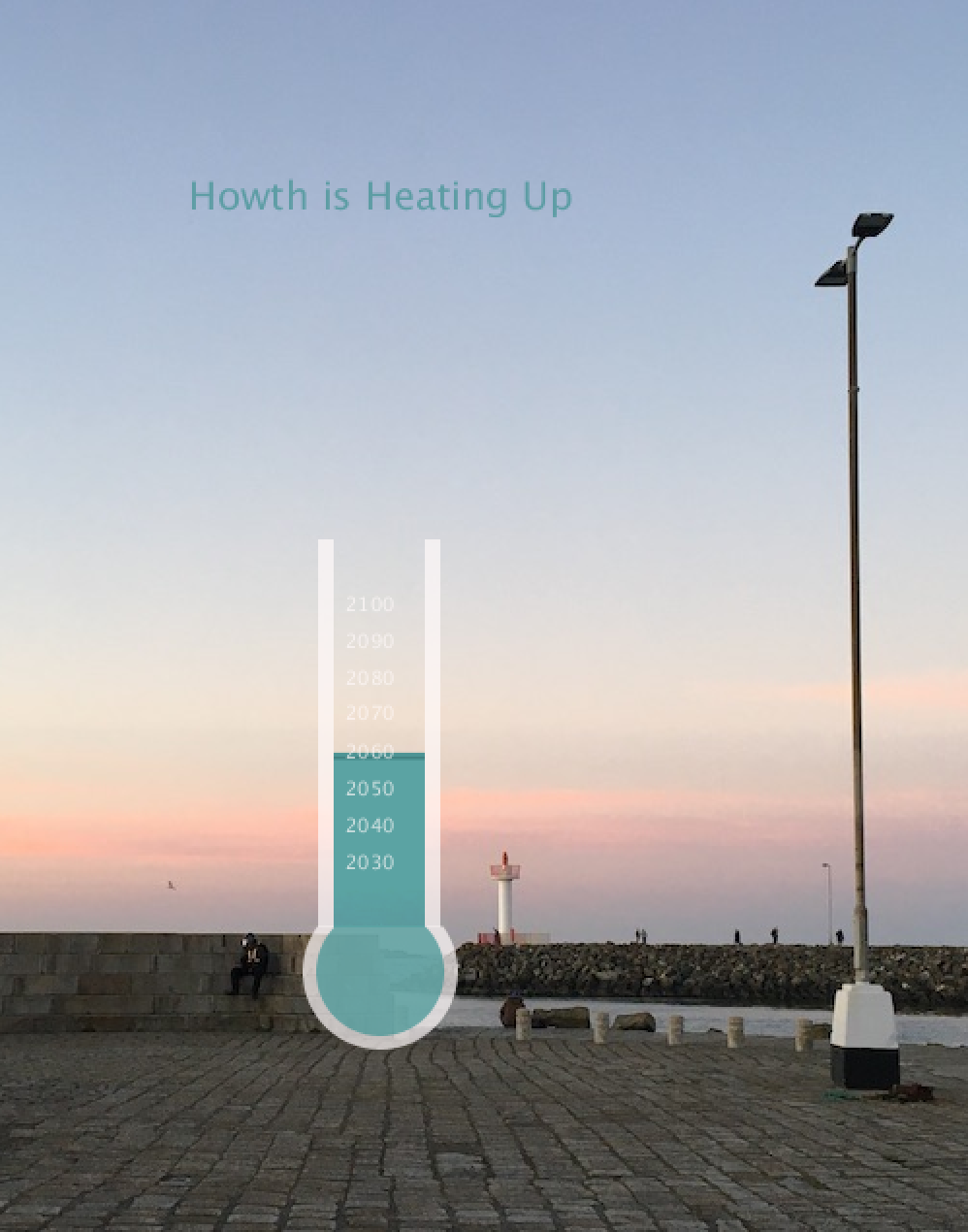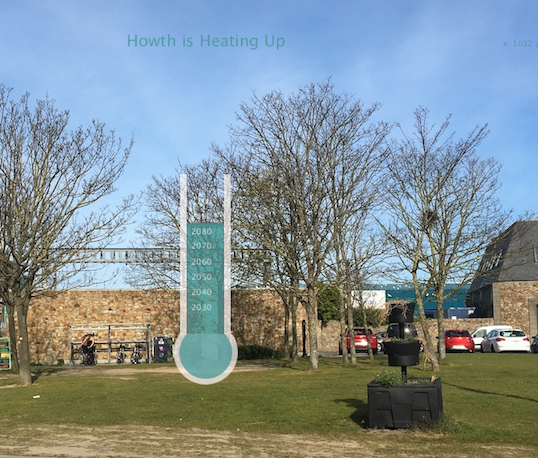Howth is Heating Up
Kerrie O'Leary
Abstract
Surrounded by the climate crisis discussion there is demand for extended means of producing science, for proposing strategies for change and reversal, and creating engagement with the public. Where once art and science were considered opposing disciplines this essay will assess how they can be mutually beneficial when addressing climate change. By drawing on the philosophies of Gyorgy Kepes, Isabelle Stengers, Bruno Latour and Jennifer Gabrys this essay explores how collaborations between art, science and technology can be a solution for drawing attention to the rising sea levels in Howth, a coastal town in Ireland.
Introduction
How can we present a proposal intended not to say what is, or what ought to be, but to provoke thought,a proposal that
requires no other verification than the way in which it is able to ‘slow down’reasoning and create an opportunity to
arouse a slightly different awareness of the problems and situation mobilizing us? (Stengers, 2005a, p. 994).
Climate change is a global problem. It is affecting everyone in the world but particularly people living in coastal areas. The increase in global temperatures is causing sea levels to rise. This is a result of water expanding as it becomes warmer and the melting of ice caps. Despite the United Nations declaring climate change an international crisis, governments are criticized for not taking the issue seriously. Major cities are facing catastrophic damages within the next ten years if action is not taken soon (The UN, 2019). New findings are printed in the headlines every day but how can the problem be presented accessibly to communities to increase the awareness of the effects that rising sea levels will have on their area?
For this project, I will investigate how science and technology can be combined with art to generate awareness surrounding the rise in sea levels. Sensing technology is an ubiquitous method that acquires quantifiable data and translates it into a readable output. This technology is used worldwide to “track air quality and temperature as well as location and speed of bodies and objects”,(Gabrys,2016). The computational process has been invaluable to understanding the developments of our environment, analysing new weather patterns and assisting the predictions of change in sea levels. The IPCC (Intergovernmental Panel on Climate Change) use floating sensors called Argo floats to follow trends in ocean currents to gain better understanding of how the melting ice caps are effecting the gulf stream current. Sensing technology is used in a computational art context frequently to visualise wind, weather, ocean and pollution conditions. These visualisations are often incorporated into mobile phone apps for people to monitor conditions in their respective locations. In order to make the research for this project a tangible size, I will be investigating how sensing technology could be used in an artistic framework to raise awareness of the rising sea levels in my hometown of Howth.
Howth is a peninsula 20 kilometres outside Dublin. The small village has become popular with tourists for its cliff walks, fish restaurants and sea views. With the estimated sea levels rising, this picturesque town is at risk of becoming an island in just 20 years. This will have devastating effects on local businesses, tourism and cause much disruption to the ecosystem and unfortunately there is a huge lack of awareness regarding this issue from locals and tourists alike.
This essay will first look at the predicted sea level rising figures for Ireland, focusing on Dublin and Howth. Scientists and environmentalists have been using sensing technology to collect information from different points around the coast of Ireland for decades. This research will be valuable for obtaining calculations and estimations for the predictions for Howth.
Next I will carry out a series of short interviews with locals to Howth. From these interviews I hope to get a better understanding of the current levels of awareness regarding the sea levels rising and an insight to what could be done to increase the awareness.
I will then look at how other artists have used art and technology to highlight the climate crisis and how they have used their practice to raise awareness and start a dialogue in both their local environment and worldwide. Using art with technology to visualize data or communicate a tough message is a powerful tool. I believe that using this technique can encourage people to stop and think about the effects climate change is having on our world.
Lastly, I will discuss existing theories relating to art, science and environmental sensing. Theorists Gygory Kepes and Isabelle Stengers have carried out independent research into ways that art can be used to communicate issues and evoke emotion and Jennifer Gabrys has written extensively on environmental computation and how these sensing tools can be used to understand behaviours in nature.
Visualising sea levels rising for Dublin and Howth
I was born in Howth and have lived here most of my life. I grew up by the sea, learnt to sail in the harbour and had picnics in the rain on the beach. Last year when the pandemic began, Ireland went in to lockdown. A 2 kilometre radius was put in place restricting everyone’s movements. With these limitations in place, the pace of life slowed down. I walked the pier every day for the two months and began to realize how different the harbour looked compared to when I learnt to sail there as a child. The break water was nearly submerged and the navigation channel had changed shape due to erosion.
I am aware that sea levels rising is an effect of global warming but I had never stopped to notice the effects first hand. As we emerged from the lock down I noticed the waterline in the fishing harbour was much higher than I remembered.
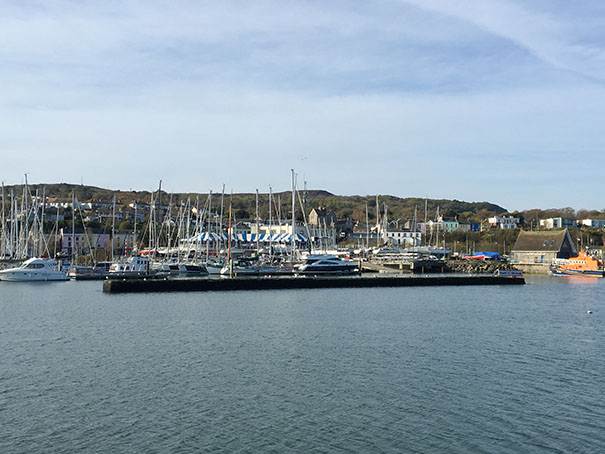

Figure 1 Breakwater at high tide
I started to question if the effects had been discussed with the council. Was anything being done to limit the damage to the harbour? Would they build on the breakwater before it becomes an invisible obstacle for boats? The big question I was asking myself however was: how many people in the community are aware that the sea levels are rising and will continue to do so?
Understanding how climate change is causing the sea levels to rise is fundamental in slowing down its effects but understanding how to initiate the discussion regarding this issue is of equal importance.
Dublin Port is situated at the mouth of The River Liffey. Here, there is a water gauge that records sea levels, this information was made public in 1938. In Howth harbour there is a similar water gauge in place that takes the same recordings. A comparable analysis was carried out on these two datasets and found that mean sea level in Dublin is 13 cm higher at the end in 2016 than in 1938 (Shoari Nejad et al. 2020). These figures are in keeping with the global mean sea level predictions carried out by IPCC.
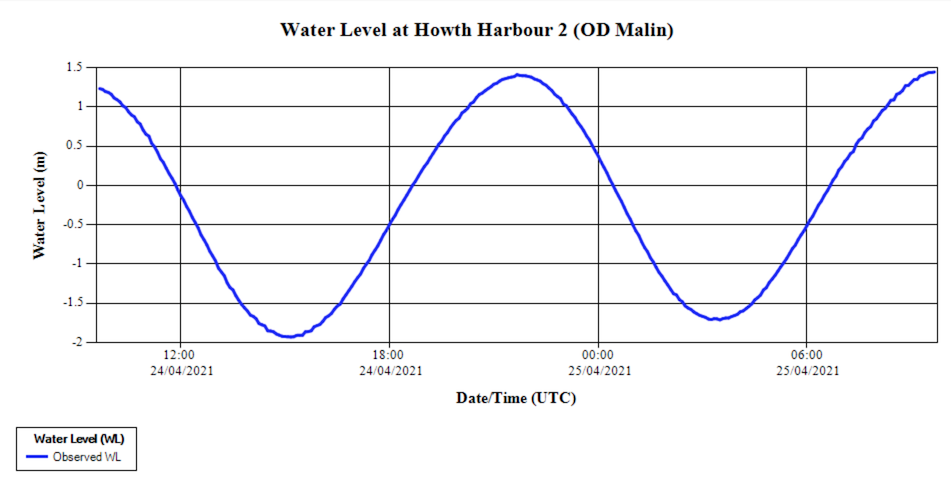

Figure 2 Water Levels recorded at Howth Harbour gauge
The Climate Central organization has a helpful interactive map of this data. The user can set the year for predictions as well as specifying the scenarios (flooding / low reduction in pollution / severe reduction etc). The image below shows the sea level rise and annual flood predicted for Howth in 2030. As you can see, it is estimated that the West Pier could be submerged during flooding periods. (*The Climate Central graphics and information is backed by scientific research and peer reviewed research papers).


There are 9 restaurants situated along the West Pier and over 12 shops on the promenade all at risk of flooding. From the map you can see that Baldoyle and Sutton are estimated to be at risk of flooding which would ultimately separate Howth from the mainland.
To understand the existing levels of awareness regarding this issue in Howth I sent out a short questionnaire to mix of locals, shop owners, fishermen and restauranteurs. One of the questions included in my questionnaire was “Are you aware that by 2030 The West Pier as we know it will be at risk of being submerged during annual flooding?” and I included the link to the map above. A few people responded with comments “That map is scary”, “I have never seen a map like this”, “these visuals really highlights what we’re facing” while other responses included “there’s never been a discussion regarding the sea levels rising” and “this is the first I’ve heard of this issue”.
Going through the answers it was disappointing to note the lack of awareness regarding the issue. Although a number of people reported acknowledging weather being more extreme in recent years they were not aware that the tides have been rising. It was clear that there is demand for information to be made available as well as visual representations of the data. I have presented the answers to make questionnaires in a short book that incorporates the estimated rise in sea levels calculated by the IPCC, you can read more here.
Below image: Climate Central predictions for Howth during annual flooding in 2030


Artistic Inspiration
“I think we all know the numbers. But numbers won’t change us. Imagination will.”, Daan Roosegard, Dutch artist
As big data has become more accessible in recent years, data visualisation has become a popular way to convert numbers into tangible information. This combined with the advances in sensing technology has led to many artists using weather data to create beautiful installations that highlight emerging wind patterns, changes in currents and also global warming.
Artivism is a relatively new movement blending activism and art that focuses on raising social, environment and technical awareness. Around the world creative minds are using a variety of mediums to produce work that will make you stop, stare and contemplate the current state of the Anthropocene.
Daan Roosegard is an innovative environmentalist who has made large scale installations that help people think in a different way. His project Waterlicht uses LEDs and lenses to create an ever changing virtual flood. It explores the potential power of living with water and the vulnerability that could be exposed. Using humidity senses the projections interact with the natural light and has a mind of its own. He hopes that the wonder created by the piece will encourage people to think and offer sustainable solutions to the climate crisis.
Lines (57° 59’N, 7° 16’W),is a breath taking installation by Finnish artists Pekka Niittyvirta and Timo Aho. Using sensing technology that interacts with the tide, the artists constructed two long LED beams to illuminate where the new water level will be as a result of climate change. Installed at an Taigh Chearsabhagh Museum & Arts Centre in Lochmaddy in Scotland, the work shows that the sea levels will surpass the foundations of the arts centre. Juxtaposing the beautiful visuals with the sad reality of our future the viewer is left contemplating how we could reverse the situation.
For the 2017 Venice Biennale, sculptor Lorenzo Quinn produced a monumental piece called ‘Support’. Emerging from a canal in Venice, two enormous hands reach out of the water to ‘support’ a building. Quinn’s work was one of the most talked about piece at the Biennale engaging much needed discussion surround the issues Venice are facing with the threat of water levels rising.
John Gerrard’s commission for Channel 4 is another inspiring artwork drawing attention to the legacy of oil. ‘Western Flag’ was built virtually, creating a landscape in a 3D world that portrays an oil site in Texas where a blag flag is omitting smoke representing the vast percentage of the carbon dioxide released at this site during the 20th Century.
These computational artworks address important environmental issues and have proved valuable in starting a dialogue between artists, practitioners and learners.
Artist, educator and theorist Gyorgy Kepes believed it a necessary balance to blend art and science. He argued that combining the two could be a strategy for restoring holism in our environment. Art in particular could play a critical role in ensuring this balance and regulation, because art allows us ‘to register and reject what is toxic and find what is useful and meaningful in our lives’ (Kepes, 1972b, p. 6)./p10. Creating a collaboration between art and science can be a mutually beneficial exercise that leading to “interthinking” and “interseeing”, terms coined by Kepes.
In her book, Program Earth, Jennifer Gabrys explores the sensing technologies in our environment that are contributing to a computational planet. She brings to our attention that these sensors do not simply track data but they create new environments and environmental interactions.
“The subjects that would be monitored and would undertake monitoring are not static entities but instead are connected up with generative processes for experiencing environments and other entities in distinct ways. This phenomenon further indicates that how environments are felt and acted upon, whether for political or interventionary purposes, is closely tied to the technologies and subjects that prehend or feel environments and have concern for environments.” Gabrys, 2016
Using these scientific approaches with art allows for the learner to engage with information presented in an accessible format. This intersection between art and science is crucial for collective thinking.
‘The active participation of multiple—and even excluded—practitioners working in multiple modes—enables ‘collective thinking’, ‘collective experimentation’ and even collective practices. ‘ Latour, 2004a, Stengers, 2005a, p1002
Based on the research carried out and the feedback I received from my questionnaire I began thinking of ways to incorporate sensing technology in a form that would attract people and engage them to start a discussion regarding the rising sea levels in Howth.
‘Howth is Heating Up’
The four artworks discussed previously played a particularly big role in inspiring me to create a piece to raise awareness of the rising sea levels in Howth. (Due to time constraints and physical limitations as a result of COVID, this is a proposed piece and a proof of concept).
After analysing the responses to my survey and incorporating Kepes’ theory regarding combing art with science, I propose a digital sculpture to raise awareness of the climate crisis in Howth. Using both the predicted rise in sea levels calculated by the IPCC and the existing water gauges in Howth Harbour I propose a digital sculpture shaped like a thermostat. The ‘readings’ of the thermostat will reflect the water levels of the harbour in real time while the measurements along the thermostat will be future year dates, not degrees. Made from thermometer could be moulded with thick Perspex and the water levels inside the thermometer would be displayed with LEDs, (please see the videos in my submission folder).
Linking the data recorded by sensors in the water gauges would create a voice for the sea, an opportunity for passers-by to engage with and observe the seas behaviour while drawing attention to its vulnerability in the form of a digital sculpture. This proposal moves beyond the two-cultured approach (of art vs. science) and suggests a more ‘fruitful solution’ with ‘open terms and contingent practices’ (Gabrys, Yusoff, 2016).
“Science has always had to theatricalise proof in order to change perceptions”, Latour, guardian. In order for the sculpture to attract more attention, I will multiply the recorded tide heights by the predicted rise in sea levels. This computational creation will result in a digital sculpture that can be seen as a way of communicating to locals and visitors alike.
This essay begins with a quote by Isabelle Stengers. She proposes slowing down thought in order to change perspective and allow for new ways of thinking. This proposed sculpture is therefore a suggestion that rethinks art and science as separate disciplines and instead remaps these practices and suggests a creative solution in the form of a sculpture with the intention of raising awareness for the rising sea levels in Howth.
Below: Gallery of images: Views of high winds at high tide in Howth Harbour / Aerial view of Howth Harbour, image source: wikipedia / Proposed locations for sculpture
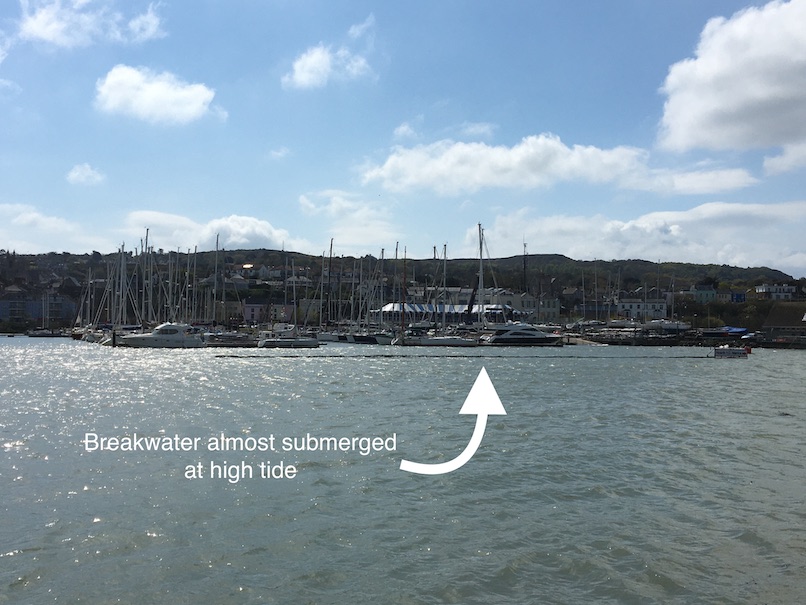
References
The UN, Only 11 Years Left to Prevent Irreversible Damage from Climate Change, Speakers Warn during General Assembly High Level Meeting, 2019 [online]https://www.un.org/press/en/2019/ga12131.doc.htm
Gabrys, J., Yusoff, K., 2012, Arts, Sciences and Climate Change: Practices and Politics at the Threshold, Science as Culture, 21:1, 1-24
Garbrys, J., (2016), Program Earth: Environmental Sensing and the Making of a Computational Planet
Stengers, I. (2005a) The cosmopolitical proposal, in: B. Latour and P. Weibel (Eds) Making Things Public: Atmospheres of Democracy, pp. 994–1003 (Cambridge, MA: MIT Press). pp. 183–196.
Bibliography
ABC News, ‘Artist uses Historic markers to raise Climate Awareness’, [online]
https://abcnews.go.com/Technology/wireStory/artist-historic-markers-raise-climate-awareness-66389190
Coastal Monky, Sea Level Rise in 2100, [online]
Gabrys, J., Ocean Sensing and Navigating the End of this World, [online]
https://www.e-flux.com/journal/101/272633/ocean-sensing-and-navigating-the-end-of-this-world/
Gabrys, J., Yusoff, K., 2012, Arts, Sciences and Climate Change: Practices and Politics at the Threshold, Science as Culture, 21:1, 1-24
Global Citizen, 6 Pieces of Climate ‘Artivism’ That Will Make You Stop and Stare, [online] https://www.globalcitizen.org/en/content/climate-crisis-activism-art-inspire-action/
Jagodzinski, J., Into the Dark Blue: A Medi(t)ation On The Oceans–Its Pain, Its Wonder, Its Wild, and Its Hope, symploke, Volume 27, Numbers 1-2, 2019, pp. 111-138
Kepes, G. (1972b) Art and ecological consciousness, in: G. Kepes (Ed) Arts of the Environment, pp. 1–12 (Aidan Ellis, UK: George Braziller).
Latour, B., 2018, The Critical Zone of Science and Politics: An Interview with Bruno Latour, [online],
https://lareviewofbooks.org/article/the-critical-zone-of-science-and-politics-an-interview-with-bruno-latour/
Marianna Michałowska,, Artists in the face of threats of climate change, Oceanologia, Volume 62, Issue 4, Part B, 2020, Pages 565-575,
Marine Institute of Ireland, Real Time Observations, [online]
http://www.marine.ie/Home/site-area/data-services/real-time-observations/tidal-observations-imos
Nejad, A., Parnell, A., Greene, A., Kelleher, B., McCarthy, G., Recent Rapid Sea Level Rise In Dublin Bay Based On Tide Gauge Analysis
Oppenheimer, M., B.C. Glavovic , J. Hinkel, R. van de Wal, A.K. Magnan, A. Abd-Elgawad, R. Cai, M. Cifuentes-Jara, R.M. DeConto, T. Ghosh, J. Hay, F. Isla, B. Marzeion, B. Meyssignac, and Z. Sebesvari, 2019: Sea Level Rise and Implications for Low-Lying Islands, Coasts and Communities. In: IPCC Special Report on the Ocean and Cryosphere in a Changing Climate [H.-O. Pörtner, D.C. Roberts, V. Masson-Delmotte, P. Zhai, M. Tignor, E. Poloczanska, K. Mintenbeck, A. Alegría, M. Nicolai, A. Okem, J. Petzold, B. Rama, N.M. Weyer (eds.)]. In press.
Stengers, I. The Cosmopolitical Proposal, 2013, [online]
https://balkanexpresss.files.wordpress.com/2013/09/stengersthe-cosmopolitcal-proposal.pdf
Jennifer Gabrys, Culture of Energy Podcast:
https://cenhs.libsyn.com/136-jennifer-gabrys
Artwork References
Daan Roosegarde, “Waterlicht”,
https://impakter.com/roosegaarde/
Pekka Niittyvirta and Timo Aho, ,Lines (57° 59’N, 7° 16’W
https://medium.com/world-ocean-forum/a-stunning-art-installation-showing-projected-sea-level-rise-fc05ef1825cd
Lorenzo Quinn, Support
https://publicdelivery.org/lorenzo-quinn-hands-venice/
John Gerrard, Western Flag
http://www.johngerrard.net/western-flag-spindletop-texas-2017.html#2019-western-flag-spindletop-texas-2017-105
Miami based murals
https://southeastfloridaclimatecompact.org/wp-content/uploads/2015/10/2015-Compact-Unified-Sea-Level-Rise-Projection.pdf
Adventure.com
https://adventure.com/art-world-bringing-awareness-climate-change/
Howth Harbour Tidal Gauge
https://www.digitalocean.ie/Data/DownloadTideData/Howth%20Harbour%202
IPCC
https://www.ipcc.ch/srocc/chapter/chapter-4-sea-level-rise-and-implications-for-low-lying-islands-coasts-and-communities/
https://www.theguardian.com/stage/2020/feb/04/bruno-latour-moving-earths-theatre-science-climate-crisis

































































